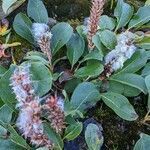Plants 0.03-0.25 m, not clonal or forming clones by layering. Stems erect, decumbent, or trailing; branches yellow-brown, gray-brown, or red-brown, (strongly glaucous or not, slightly glossy), glabrous; branchlets yellow-brown, red-brown, or violet, (strongly glaucous or not), usually densely villous or pilose (usually appearing unkempt), sometimes glabrous, (inner membranaceous bud-scale layer free, not separating from outer layer). Leaves: stipules absent, rudimentary, or foliaceous (0.2-1.5-10 mm); petiole 2-35 mm, (longer than subtended bud, puberulent or glabrous adaxially); largest medial blade hypostomatous or hemiamphistomatous, narrowly to broadly elliptic, subcircular, circular, oblanceolate, obovate, or broadly obovate, 10-85 × 5.5-60 mm, 1-3.6(-4.9) times as long as wide, base cuneate, convex, or rounded, margins slightly revolute or flat, entire, apex acuminate, acute, convex, or rounded, abaxial surface pilose or midrib sparsely short-silky, or apex long-silky bearded, hairs usually straight or wavy, adaxial slightly glossy or dull, glabrous, pilose or long-silky margin; proximal blade margins entire; juvenile blade glabrous or sparsely villous abaxially, hairs straight, oriented toward apex. Catkins: staminate 14-65 × 5-18 mm, flowering branchlet 2-36 mm; pistillate densely to moderately densely flowered (30+ flowers), slender, stout, or subglobose, 20-145 × 8-22 mm, flowering branchlet 2-40 mm; floral bract brown or black, 1.6-3.7 mm, margins sometimes sinuate, apex broadly rounded, convex, or retuse, entire, sinuate, or 2-fid, abaxially hairy, hairs straight. Staminate flowers: abaxial nectary (0-)0.3-0.8 mm, adaxial nectary narrowly oblong, oblong, or square, 0.5-1.2 mm, nectaries distinct; filaments distinct; anthers ellipsoid, 0.3-0.9 mm. Pistillate flowers: adaxial nectary oblong, ovate, or narrowly oblong, 0.4-1.8 mm, much longer than stipe; stipe 0.2-1.6 mm; ovary obclavate or pyriform, villous, beak abruptly to gradually tapering to or slightly bulged below styles; ovules 12-15 per ovary; styles (connate to distinct 1/2 their lengths), 0.6-2.2 mm; stigmas slenderly cylindrical, 0.35-0.56-0.88(-1.13) mm. Capsules 4-9 mm. 2n = 76, 114.
More
Branchlets yellowish, becoming russet or chestnut colored, glabrous. Petiole (3-)5-10 mm, rather thick, notched, pilose; leaf blade long obovate, elliptic, or ovate, 2-3 × 1-2 cm, abaxiallygreenish, glabrous or along midvein sparsely long pubescent, pilose when young, adaxially green, base broadly cuneate, margin entire, apex obtuse. Catkins borne on distal part of branchlets, thinly cylindric, 2-3 cm; bracts russet, long elliptic, adaxially villous. Male flower: stamens 2, free. Fruiting catkin elongated; peduncle with leaflets, tomentose. Femaleflower: ovary long cylindric, tomentulose; style ca. 1 mm; stigma 2-parted. Capsule russet, 5-6 mm, slightly pilose. Fl. Jun-Jul, fr. Aug. 2n = 76, 100, 114.
A prostrate shrub. It grows up to 60 cm high. It grows in clumps and these form dense mats.
Various wet to dry habitats, including tundra, snowbeds, pond margins, beach, shale & gypsum ridges, gneissic cliffs, talus slopes, moraines, poorly drained calcareous silty till, muddy salt flats, heavy clay, dry calcareous gravel, coarse sandy soil
More
It grows in tundra and exposed sites in north Canada.

